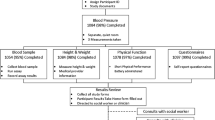Abstract
Recruitment of community participants for clinical research studies is a challenging task. When possible, community-based recruitment efforts should involve members of the targeted community in the planning, community preparation, and actual recruitment process. It becomes even more difficult to recruit study participants from the community when the research involves an invasive procedure, or when diverse target groups require that a variety of recruitment methods be used. The Community Health and Stress Evaluation (CHASE) Study was designed to determine the role of psychosocial and biobehavioral factors in the etiology of coronary heart disease. It involved both an invasive medical procedure (a spinal tap) and the collection of survey and medical information from Black and White persons in different socioeconomic status (SES) groups. Interestingly, we experienced the greatest difficulty in recruiting lower SES white persons, while groups that typically are “difficult to find” (such as Blacks) were actually easiest to recruit for the study. This paper describes the background of the CHASE study, the community recruitment methods used, and the results of the recruitment efforts by race, gender and SES gradient. We present an evaluation of the community recruitment component, why we think differences occurred, and the lessons learned from the experiences that may be applied to similar studies.
Similar content being viewed by others
REFERENCES
Shelton BJ, Wofford JL, Gosselinket CA, et al. Recruitment and retention of physicians for primary care research. J Community Health 2002; 27:79–89.
Williams RB, Marchuk DA, Gadde KM, et al. Central nervous system serotonin function and cardiovascular responses to stress. Psychosom Med 2001; 63:300–305.
Surwit RS, Williams RB, Siegler IC, et al. Hostility, race and glucose metabolism in nondiabetic individuals. Diabetes Care 2002;25: 835–839.
Williams RB, Marchuk DA, Gadde KM, et al. Serotonin-related Gene Polymorphisms and Central Nervous System Serotonin Function. Neuropsychopharmacology 2003; 28:533–541.
Hatch JW, Moss N, Saran A, Presley-Cantrell L, Mallory C. Community research: Partnership in black communities. Am J Prev Med 1993; 9:27–31.
Bracht N, Finnegan JR, Rissel C, et al. Community ownership and program continuation following a health demonstration project. Health Educ Res 1994; 9:243–255.
Galbraith J, Ricardo I, Stanton B, Black M, Feigelman S, Kaljee L. Challenges and rewards of involving community in research: An overview of the “Focus on Kids” HIV risk reduction program. Health Educ Q 1996; August: 383–393.
Boles M, William GS, Feldman G, McBride R, Robert G. Primary prevention studies and the healthy elderly: Evaluating barriers to recruitment. J Community Health 2000; 25:279–292.
McLeroy KR, Kegler M, Steckler A, Burdine JM, Wisotzky M. Editorial: Community coalitions for health promotion: Summary and further reflections. Health Educ Res 1993; 4:1–11.
Author information
Authors and Affiliations
Rights and permissions
About this article
Cite this article
Burroughs, A.R., Visscher, W.A., Haney, T.L. et al. Community Recruitment Process by Race, Gender, and SES Gradient: Lessons Learned from the Community Health and Stress Evaluation (CHASE) Study Experience. Journal of Community Health 28, 421–437 (2003). https://doi.org/10.1023/A:1026029723762
Issue Date:
DOI: https://doi.org/10.1023/A:1026029723762




